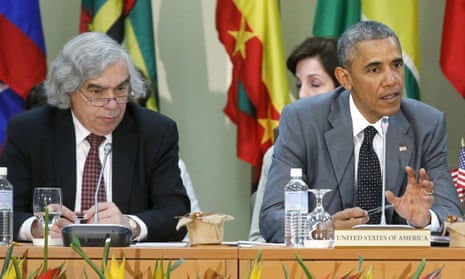The world has been lucky so far to escape the launch of nuclear weapons through miscalculation, but the odds of such a catastrophic accident are increasing, according to the former US energy secretary Ernest Moniz.
Moniz, a nuclear physicist who played a central role in securing a landmark non-proliferation agreement with Iran in 2015, said the margin for error in avoiding disaster was getting thinner because of the introduction of new, smaller weapons, the broadening of circumstances in which their use is being contemplated, and a lack of high-level communications between major nuclear weapons powers.
As a result, Moniz told the Guardian, the chance of nuclear use “is higher than it’s been since the Cuban missile crisis”.
Moniz, who is now CEO and co-chairman of the Nuclear Threat Initiative, pointed to a recent false alarm by Hawaii’s public alert system as the sort of technological glitch that could lead to fatal miscalculation. The alert sent islanders running for cover, and it took nearly 40 minutes for the mistake to be rectified.
“Thirty-eight minutes is substantially longer than the decision time that President Trump or President Putin or other leaders with nuclear weapon states would have for a response to a warning about significant incoming missiles,” Moniz said.
“We know we’ve had those warnings many times in history and we’ve managed so far to dodge the bullet,” he said. “But dodging the bullets is more difficult when there’s not significant communications going on and a lot of tensions between the countries.”
Both the US and the Soviet Union came close to launching their nuclear weapons several times over the course of the cold war because technical glitches or faulty analysis gave the false impression they were under imminent attack.
Moniz said the risks of miscalculation had been further heightened by two elements of the Trump administration’s nuclear posture review, published earlier this month.
The review calls for the development of a low-yield submarine-launched missile, which critics say risks being seen by generals and political leaders as more “usable” than megaton thermonuclear weapons.
The same criticism is made of plans, inherited from the Obama administration, to spend $10bn modernising another tactical nuclear weapon, the B61 gravity bomb.
In a new report this week, the NTI warned that the weapons may be useless as a deterrent and constitute a potentially catastrophic security liability.
Trump’s nuclear posture review also expands the conditions in which the US might consider using its nuclear arsenal to include devastating attacks on infrastructure, including cyber-attacks.
“The use of a new class of submarine-launched smaller weapons seems to us to just add to the issues of miscalculation,” Moniz said. The former head of the Massachusetts Institute of Technology physics department added that widening the conditions of nuclear use to include cyber-attack was particularly worrisome as it is rarely absolutely clear who was responsible for such attacks.
“A major infrastructure cyber-attack could not be a nationally endorsed attack at all. It could be from some third-party hackers who might enjoy a nuclear exchange between the two major powers,” he said.
Moniz said the world had been even luckier so far to have been spared a terrorist dirty bomb attack, in which conventional explosives are used to spread radioactive material over a wide area.
“The consequences are less [than a nuclear detonation] but the probabilities are much higher,” Moniz said.
He pointed out that at the time Mosul fell to Islamic State in 2014, there was a large stockpile of lethal cobalt-60, used to treat cancer, at the medical faculty of the city’s university. Isis did not take advantage of the cache.
He said the international community should also step up efforts “quietly and systematically” to replace medical sources of radioactive caesium, before its luck runs out.
“I would say it’s kind of remarkable that we have not had a significant incident to date in that realm,” he said.
